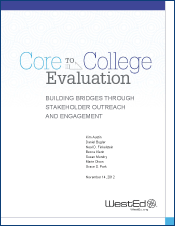Reducing Remediation Rates by Using Multiple Measures for Course Placement Decisions
Posted on

Each year, more than two-thirds of students entering public two-year colleges in the United States are required to take one or more remedial classes before they can enroll in courses that carry college credit. While remedial classes are intended to ensure students’ success in college, they are often an unnecessary or even self-defeating step — slowing student progress toward postsecondary goals or leading students to give up completely.
Low completion rates are a huge concern for community college leaders, says WestEd Senior Research Associate Kathy Reeves Bracco, because of the hefty costs in time and resources for both students and colleges. “Currently, many states are reevaluating their college readiness and college course placement policies in light of the Common Core State Standards,” Bracco says. “This reassessment has created good opportunities to investigate what’s working and what is not.”
Bracco is part of the WestEd team evaluating Core to College, a three-year, multistate initiative aimed at bringing together personnel from K–12 and postsecondary education systems in each state to improve college enrollment and success rates in the era of Common Core. As evaluator, WestEd is helping states make informed policy and practice decisions by documenting their efforts to improve students’ college readiness and success; facilitating cross-state dialogue on successful strategies and ongoing challenges; and aggregating and disseminating the latest research on timely issues.
The evaluation team has recently carefully reexamined one of those issues: how community colleges can improve course placement decisions for incoming students. “Currently, 92 percent of the nation’s community colleges assign students to remedial classes based on the results of a single standardized placement test,” Bracco says. “But the research shows that these tests can have high rates of ‘severe error,’ particularly when used as the sole basis for course placement.”
As one means to improve college persistence rates, several Core to College states are implementing or testing the use of multiple measures — such as high school GPA or grades in core high school courses, instead of, or in addition to, a placement test — for making decisions on course placement. According to one recent study, for example, using multiple measures can reduce the remediation rate by 8 to 12 percent, while maintaining or increasing rates of success in college-level courses.
In its latest evaluation report, Core to College Evaluation: Exploring the Use of Multiple Measures for Placement into College-Level Courses, WestEd documented the progress of seven Core to College states — Colorado, Florida, Hawaii, Massachusetts, North Carolina, Tennessee, and Washington — that are implementing various multiple-measures approaches to improve course placement decisions. The report includes a detailed case study of North Carolina, which is addressing college placement and completion challenges similar to those faced by many other states.
North Carolina: “Hard to argue with our own data”
Leaders of the North Carolina Community College System (NCCCS) had become increasingly concerned that the system’s reliance on standardized test scores alone was resulting in the majority of its students being placed into remediation — at significant cost to both the students and the system. So, in 2011, North Carolina contracted with the Community College Research Center (CCRC) to find better alternatives.
The results of that study were sobering. The research revealed that NCCCS’s current approach was leading to approximately one-third of its students being severely misplaced — a number that would have been cut in half by using high school GPA for placement decisions. “These were our students,” says John Denning, the State Director of K–12 and Postsecondary Alignment Initiatives at the time of the study, “and it was hard to argue with our own data.”
Prompted by these findings, North Carolina established a hierarchy of measures that looked first at students’ high school GPA to determine whether they would be placed into remedial or college-level courses. Kirby H. Moore, the admissions director at Mitchell Community College in Statesville, North Carolina, says GPA has quickly proven to be a better predictor of performance in credit-bearing classes than traditional placement tests. “We found that we had previously been putting a lot of students in lower-level courses who didn’t need to be there,” says Moore.
For example, 74 percent of students who were placed in the college’s entry-level, credit-bearing English class based on earning a high school GPA of 2.6 or higher completed the course with a grade of at least a C. That compares to 65 percent for those placed in the class on the basis of a placement test score or after completing a course in remedial English.
In math, 64 percent of students who were placed in College Algebra based on their high school GPA earned a grade of C or better, compared to 59 percent for those placed in the class on the basis of a placement test score or after completing a course in remedial math.
Multiple measures gaining ground
Given such findings, it’s not surprising that the use of multiple measures for college placement decisions is gaining ground, says Bracco. “The fact is, large numbers of students are being placed in remediation but still not succeeding. Everyone knows something needs to change.”
In addition to a case study of North Carolina, the WestEd report identifies ways that other states and colleges are working to implement multiple measures for placement. Many approaches involve ongoing communication and collaboration between K–12 and postsecondary educators, particularly around the expectations that colleges have for incoming students and the content and expectations that high schools have for students in key courses during grades 11 and 12.
Massachusetts officials have been concerned by the alarmingly high number of students placed into, and languishing in, remedial education. In 2010, for instance, only 20 percent of students who completed remedial math at a Massachusetts community college went on to complete a college-level math course within two years — and the percentages were even lower for African American, Latino, and low-income students.
The state recently proposed a revision to its placement policy in order to implement the use of multiple measures — including high school GPA, high school course results, and standardized test results — to determine whether students are placed into remedial or college-level courses. This new policy, which is being pilot tested during the 2014/15 academic year, allows recent Massachusetts high school graduates whose GPA is between 2.4 and 2.7 and who have successfully passed four math courses (including one class in their senior year) to be placed directly into the college-level math course needed for their field of study.
Meanwhile, Hawaii is experimenting with using grades in specific high school courses to inform whether or not students are placed into credit-bearing courses. Pilot studies underway in two of Hawaii’s community colleges allow students who meet a specific cut score on their final exam in Algebra II and a B or higher in the course to be automatically placed into a college-level math course as long as they enroll within 18 months of taking the exam.
Multiple measures are better predictors of success
Researchers believe that one reason multiple measures are better predictors of college success is because that success depends on a variety of cognitive and non-cognitive skills and attributes — and any one measure on its own cannot assess all of them.
Some community college systems have been hesitant to use high school GPA for placement decisions, believing it may be too subjective — an assumption not borne out by the research. In fact, studies indicate that even using high school GPA as the sole measure for placement decisions decreases “severe error” in college placement by 10 to 30 percent compared to the use of a single standardized test; and using a combination of high school GPA and standardized test results is a better predictor for college placement than any one measure alone.
“This result offers evidence that the GPA, itself, is essentially a multiple measure,” says Bracco, “It incorporates performance results on numerous projects and assessments in several content areas over a sustained period of time.”
Although many states still rely on a single standardized test to determine course placement, the evidence is mounting for the need to update those policies. At a time when community college is increasingly seen as an affordable route to improved career prospects and long-term success for many students, says Bracco, “it’s critical to make sure we are doing everything we can to help community college students be successful.”
The Core to College Initiative is funded by the Lumina Foundation, the William and Flora Hewlett Foundation, the Bill & Melinda Gates Foundation, and the Carnegie Corporation of New York, with Rockefeller Philanthropy Advisors as the fiscal sponsor.

